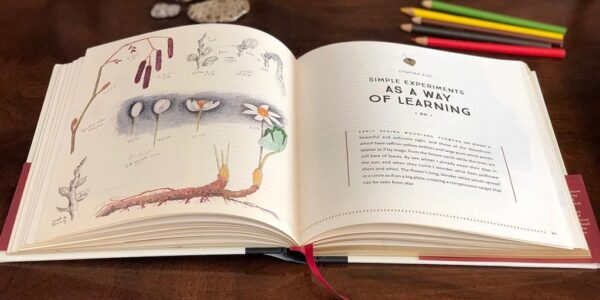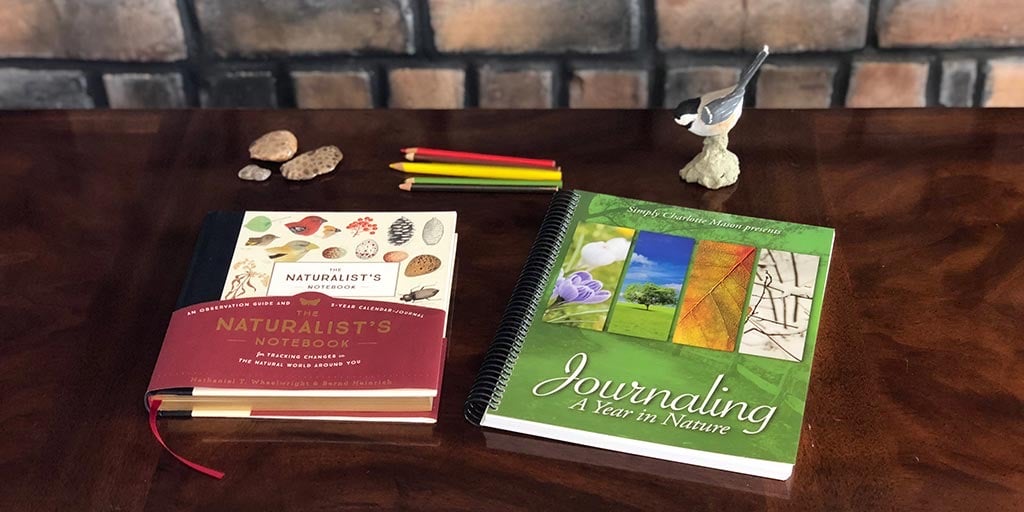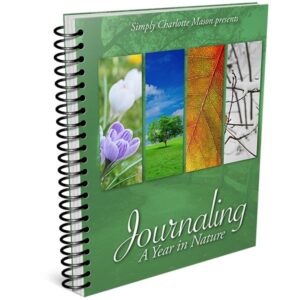60-day returns • free shipping on USA orders $129+
(The Naturalist’s Notebook: An Observation Guide and 5-Year Calendar-Journal for Tracking Changes in the Natural World Around You by Nathaniel T. Wheelwright and Bernd Heinrich, Storey Publishing, 2017.)
I’ve discovered something about nature study. It’s not a static activity. By that I mean, it’s not just one-dimensional: go outside, observe, record in your nature notebook. The end.
The more I do nature study, and the more I watch and talk with my go-to-nature-friend, Karen Smith, about nature study, the more I become convinced that there are many levels to it.
I was pondering this today, and if I were to boil down nature study into five levels, they would be
- Observe and record observations—This is where it starts. This is what we encourage our children to do every week. But it’s not the end. Eventually they (and we) should start to . . .
- Notice changes—When you get to know an animal or plant well, you will notice when things look different, whether the whole or just a part. You’ll spot when something changes it habit. And the more you notice those changes, the more you will begin to . . .
- Recognize recurring changes—You’ll recognize the seasonal rhythms as they play out in creation around you, noticing the same events in spring and fall. But even that is not the end of the road with nature study. If you keep observing and recording, eventually you will begin to . . .
- Anticipate recurring changes—You’ll know what kinds of things you can expect to see in the various seasons of the year. You’ll confidently watch for familiar natural events and nature friends coming and going. And when you have achieved that level of nature study, it’s not too big of a step to . . .
- Analyze records to discover more—At this level you go back over your records from years of observations and look for broader changes over longer periods of time. You also set up simple experiments to test your findings and track the results.
You might be anywhere among those levels. Hopefully, you are naturally progressing from one toward the next. If you happen to be near levels 3 or 4, The Naturalist’s Notebook will help you get to the next level. Karen brought me a copy on her latest visit, and we agreed that you need to know about this wonderful resource.
The Naturalist’s Notebook contains a lot of encouragement and practical help combined with personal anecdotes and discoveries from two authors who have enjoyed a lifetime of nature study. You will find an occasional evolutionary or global warming comment, but those do not negate all of the helpful and practical ideas that you will gain for your own nature study.
With an appealing conversational style, the authors discuss being attentive, how to become an observant naturalist, a naturalist’s toolbox, simple experiments through the seasons, and knowing nature where you are (including in the city). We noted with pleasure that they warmly recommend Anna Botsford Comstock’s book, The Handbook of Nature Study.
The second half of the book is what makes this resource unique. It contains a 5-year calendar-journal for you to use in recording nature observations. The emphasis (and space) is mainly on recording short daily observations in writing, but the authors do recognize the benefits of drawing.
“Drawing is making a personal connection to our unique, individual reality. It is thus a potentially important addition to a journal. Unless I have a personal experience with something that catches my eye, creates in me a feeling of wonder, and demands to be preserved, I find it close to impossible to draw it.
“At that same time, I feel that I have not really seen something until I’ve drawn it” (p. 48).
The 5-year journal itself contains no room for drawings; however, the entire book is illustrated with sketches and drawings that Bernd Heinrich has done in his notebooks over 60 years of studying nature. And he encourages you to keep a separate sketchbook for your own.


In the explanatory chapters, the authors begin with observation, of course, but they also expand into explaining how to level-up your nature study. With their guidance and the succinct 5-year journal format, you will soon move to the 4th and 5th levels listed above.
With each year’s observations displayed side by side, you will learn to anticipate what things to look for during the different seasons. By the way, that’s what Karen Smith has compiled in her guided nature journal, Journaling a Year in Nature. Those who use her weekly nature study prompts benefit from her decades of nature study and knowledge of what she has observed repeatedly happening in the natural world over the years.
As you continue to record your observations over several years, the authors will guide you into summarizing and analyzing them over those longer stretches of time and conducting simple experiments to learn more about the natural world around you.
Those of you who are ready to level-up your nature study, you’ll want to take a look at The Naturalist’s Notebook. Those of you who are on the first or second level of nature study, keep doing it. Don’t worry about where you think you should be. Simply enjoy the process as you and your children form relations with the natural world around you.
“Let yourself get carried away by curiosity. If you work on becoming an observant naturalist at a pace that feels comfortable to you, and if you continue the practice over time, you will be amazed at how much you can teach yourself” (p. 19).
A Year of Weekly Nature Study
Journaling a Year in Nature gives you a weekly prompt of what to look for in your nature study time. Its durable cover can stand up to treks in the out-of-doors and its heavy paper is perfect for drawing or painting. This guided nature journal will take you by the hand and walk you through the seasons of the year, helping you develop a habit of enjoying and learning about God’s creation.
Podcast: Play in new window | Download



I was literally *just* going to post in the forum about A Naturalist’s Notebook, which we’ve just started using. The artwork in it is marvelous. We leave it open on our school table, and when we come in from our morning walk, or even when we just observe something from inside, we record it. My 8yo daughter especially likes that we can make up our own abbreviations and put them in the glossary in the back. Since we live in the city, we don’t have as great a variety of wildlife as some may who live in more rural environments, but there are some creatures we see daily, so they need their own codes. : ) This book will be so lovely to look at over the years to help us remember special sightings. For instance, recently we saw our first-ever osprey!
We have the Year in Nature books, too, which I’m saving for when my daughter is a little older. Thank you for all you do to make nature study possible.
How large are the spaces to record in?
Each space in the 5-year calendar is 1.75 inches wide and 1.5 inches high and has 6 marked lines for writing on.
I already own a calendar of firsts (red mountain community school version). I wondered if this book is more a calendar, or more of an inspirational nature study book. I love inspirational nature study books, but don’t want to duplicate if it is pretty much a calendar. Any thoughts?
It is pretty much half and half. About half of it is the inspirational and practical ideas, and half of it is the five-year calendar.